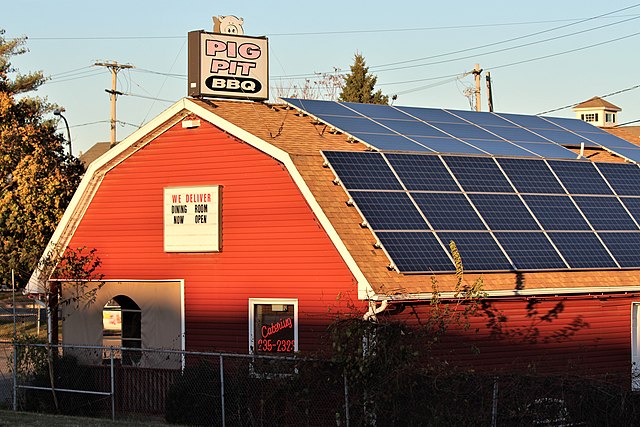An international research group has simulated the coupling of bifacial PV panels with proton exchange membrane (PEM) reversible fuel cells (RFC) to power commercial buildings.
The simulation was conducted across five locations in the United States: Tucson, Arizona; Los Angeles, California; Denver, Colorado; Dallas, Texas; and Minneapolis, Minnesota.
“One of the most surprising results of the research is the significant cost reductions achieved by increasing the bifacial PV gain,” corresponding author, Ahmad Mayyas, told pv magazine. “This enhancement led to reductions in the levelized cost of electricity (LCOE) by 16%, levelized cost of hydrogen (LCOH) by 14%, and levelized cost of storage (LCOS) by 13%. Another surprising insight is the system’s adaptability across a range of climates—from the arid conditions in Tucson to the colder environment in Minneapolis—demonstrating not only significant energy yield improvements but also remarkable cost efficiency across diverse geographical locations.”
The energy demand data for the locations have been obtained from the US Department of Energy’s National Renewable Energy Laboratory (NREL), assuming full-service restaurants with an average hourly load demand of 20.33 kWh, 27.87 kWh, 116.98 kWh, 46.62 kWh, and 32.51 kWh in Dallas, Denver, Los Angeles, Minneapolis, and Tucson, respectively. Weather data for these regions were obtained from the National Solar Radiation Database, which shows that global horizontal irradiance (GHI) spans from 1,400 kWh/kWp/year to 2,100 kWh/kWp/year.
The bifacial PV system was simulated under different rear gain conditions of 0%, 5%, 10%, and 20%. The system was assumed to power the building, while any excess energy is used to produce hydrogen or sold to the grid if the hydrogen tank is full. When solar energy is lacking, the reversible fuel cells kick into action, producing electricity to satisfy the restaurant’s load. In case hydrogen runs out, electricity is supplied by the grid.
“The optimal sizes from grid search optimization technique were identified by carefully considering factors such as grid impact, capital costs, and adherence to net metering principles,” the academics explained. “The primary objective of determining optimal sizes was to minimize excess energy export to the grid. Sizes greater than the optimum could potentially lead to unnecessary strain on the grid network and increase capital costs.”
Per the optimization, in Tucson, the PV system had a capacity of 300 kW, 1,200 kW in Los Angeles, 350 kW in Denver, 300 kW in Dallas, and 900 kW in Minneapolis. The electrolyzer/fuel cell size was 200/84.5 kW, 700/296.1 kW, 200/84.5 kW, 200/84.5 kW, and 400/169.2 kW, respectively. Inverter sizes were 100 kW in Tucson, 300 kW in Los Angeles, 100 kW in Dallas and Denver, and 200 kW in Minneapolis. Hydrogen tank sizes were 150 kg, 500 kg, 150 kg, and 250 kg, respectively.
“The increase in PV gain emerged as a potent lever for optimizing economic efficiency. In the Tucson area, which has high GHI, the LCOE from PV systems is $0.034 per kWh for PV systems without bifacial gain,” the researchers stated. “However, with a 20% bifacial PV gain, the LCOE decreases to $0.029 per kWh. Similarly, in Minneapolis, which has the lowest GHI, the LCOE for standard PV systems is $0.051 per kWh, reducing to $0.043 per kWh with bifacial gain.”
In addition, the researchers found that for the LCOH, there is a reduction of $0.6 per kg with increased PV gain across all regions. “For the LCOS, there is a decrease of $0.06 per kWh, and the overall system LCOE shows a reduction of at least $0.02 per kWh in every region analyzed,” they also explained.
Their findings were presented in “Harvesting energy horizons: Bifacial PV and reversible fuel cells unite for sustainable building solutions,” published in the International Journal of Hydrogen Energy. Scientists from the United States’ Lawrence Berkeley National Laboratory, the U.S. Army Corps of Engineers, and the United Arab Emirates’ Khalifa University of Science and Technology conducted the research.
This content is protected by copyright and may not be reused. If you want to cooperate with us and would like to reuse some of our content, please contact: editors@pv-magazine.com.








By submitting this form you agree to pv magazine using your data for the purposes of publishing your comment.
Your personal data will only be disclosed or otherwise transmitted to third parties for the purposes of spam filtering or if this is necessary for technical maintenance of the website. Any other transfer to third parties will not take place unless this is justified on the basis of applicable data protection regulations or if pv magazine is legally obliged to do so.
You may revoke this consent at any time with effect for the future, in which case your personal data will be deleted immediately. Otherwise, your data will be deleted if pv magazine has processed your request or the purpose of data storage is fulfilled.
Further information on data privacy can be found in our Data Protection Policy.